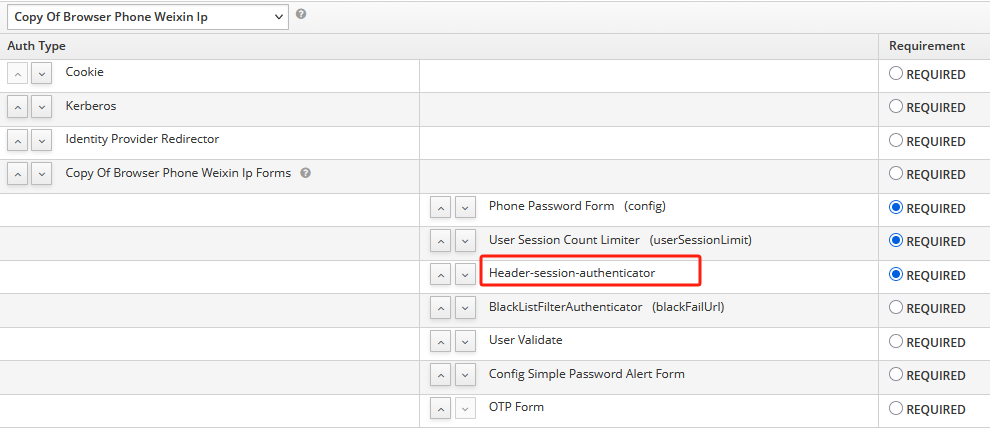keycloak~登录时将请求头里某个属性放入UserSessionModel
UserSessionModel做为用户登录过程中的一个会话,可以用来跨flow使用数据,这些数据被保存到内存里,在认证过程中可以被使用,今天的一个需求要求在登录时从请求头获取IP所在地并写到kafka里,要想实现这个需求,你可以在现有认证流程中修改代码,但不建议这样做,因为这种修改对原始逻辑会有破坏,keycloak提供了自定义认证流,并在后台可以灵活的配置。

相关keycloak中的知识
认证流程的执行动作
从上面图中可以看到,这个登录的过程会经历多个认证流,在所有被开启的认证流执行完成后才算登录成功,而这些流程我们是可以进行按需开发并配置的,下面说一下keycloak认证过程的几大事件,以表单登录为例(社区三方认证流程更复杂一些:
- 表单提交
- 标准用户密码认证流执行
- 扩展认证流执行
- 会话限制 User Session Count Limiter
- 请求头到session的转换 Header-session-authenticator
- 黑名单控制 BlackListFilterAuthenticator
- 用户有效性控制 User Validate
- 弱密码提醒 Config Simple Password Alert Form
- MFA多因子认证 OTP Form
- 执行jwt token构建流程,包含自定义的
AbstractOIDCProtocolMapper等 - 发布Login登录成功事件
- 订阅了Login事件的监听器可以写入kafka消息
keycloak认证流程相关元素
- 浏览器认证流Browser Flow 继承AbstractUsernameFormAuthenticator类
- 直接认证流Direct Grant Flow 继承BaseDirectGrantAuthenticator类
- 用户所需要动作Require Action 实现RequiredActionProvider接口
- 表单页面Form Action,实现了FormAction接口
关于登录事件Login扩展的分析
- 在AbstractUsernameFormAuthenticator实现类中,添加登录扩展参数
- 定义一个认证流,专业处理这块请求头参数,并把它放入登录事件
- 定义一个Login事件监听器,在收到后信息后,可进行中间件转发
- 如果需要扩展token中的属性,也可以通过扩展认证流来实现,将数据存入userSession,并且在AbstractOIDCProtocolMapper阶段读取userSession的内容写入到jwtToken中
实现步骤
下面自定义一个从请求头获取属性写入userSessionModel的例子
@JBossLog
public class RequestHeaderToSessionNoteAuthenticator implements Authenticator {
private final KeycloakSession session;
public RequestHeaderToSessionNoteAuthenticator(KeycloakSession session) {
this.session = session;
}
@Override
public void authenticate(AuthenticationFlowContext context) {
HttpHeaders httpHeaders = context.getHttpRequest().getHttpHeaders();
if (httpHeaders.getRequestHeaders().containsKey(UserUtils.EO_CLIENT_REGIONNAME)) {
context.getAuthenticationSession().setUserSessionNote("lastLoginProvince",
URLDecoder.decode(httpHeaders.getHeaderString(UserUtils.EO_CLIENT_REGIONNAME)));
context.getEvent().detail("lastLoginProvince",
URLDecoder.decode(httpHeaders.getHeaderString(UserUtils.EO_CLIENT_REGIONNAME)));
}
if (httpHeaders.getRequestHeaders().containsKey(UserUtils.EO_CLIENT_CITYNAME)) {
context.getAuthenticationSession().setUserSessionNote("lastLoginCity",
URLDecoder.decode(httpHeaders.getHeaderString(UserUtils.EO_CLIENT_CITYNAME)));
context.getEvent().detail("lastLoginCity",
URLDecoder.decode(httpHeaders.getHeaderString(UserUtils.EO_CLIENT_CITYNAME)));
}
context.success();
}
private EntityManager getEntityManager() {
return this.session.getProvider(JpaConnectionProvider.class).getEntityManager();
}
@Override
public void action(AuthenticationFlowContext context) {
}
@Override
public boolean requiresUser() {
return false;
}
@Override
public boolean configuredFor(KeycloakSession session, RealmModel realm, UserModel user) {
return false;
}
@Override
public void setRequiredActions(KeycloakSession session, RealmModel realm, UserModel user) {
}
}
public class RequestHeaderToSessionNoteAuthenticatorFactory implements AuthenticatorFactory, ConfigurableAuthenticatorFactory {
public final static String PROVIDER_ID = "header-session-authenticator";
@Override
public String getDisplayType() {
return "header-session-authenticator";
}
@Override
public String getReferenceCategory() {
return null;
}
@Override
public boolean isConfigurable() {
return false;
}
@Override
public AuthenticationExecutionModel.Requirement[] getRequirementChoices() {
return REQUIREMENT_CHOICES;
}
// 是否针对用户有require action动作,如果没有,requiresUser()返回也为false
@Override
public boolean isUserSetupAllowed() {
return false;
}
@Override
public String getHelpText() {
return "header-session-authenticator";
}
@Override
public List<ProviderConfigProperty> getConfigProperties() {
return null;
}
@Override
public Authenticator create(KeycloakSession keycloakSession) {
return new RequestHeaderToSessionNoteAuthenticator(keycloakSession);
}
@Override
public void init(Scope scope) {
}
@Override
public void postInit(KeycloakSessionFactory keycloakSessionFactory) {
}
@Override
public void close() {
}
@Override
public String getId() {
return PROVIDER_ID;
}
}
最后在resources/META-INF/services/org.keycloak.authentication.AuthenticatorFactory中添加你的这个Factory即可。


 浙公网安备 33010602011771号
浙公网安备 33010602011771号